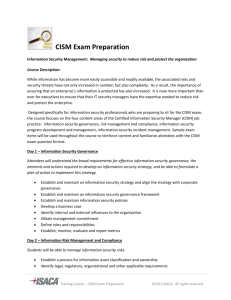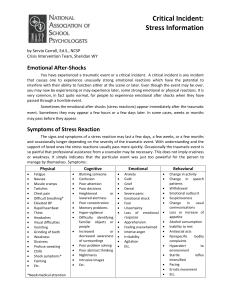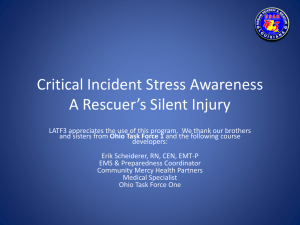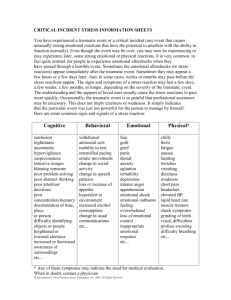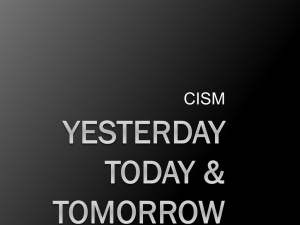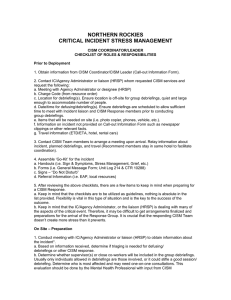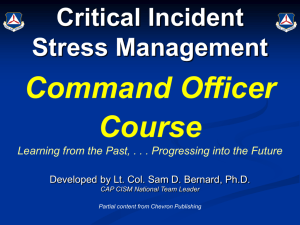Critical Incident Stress Management
advertisement
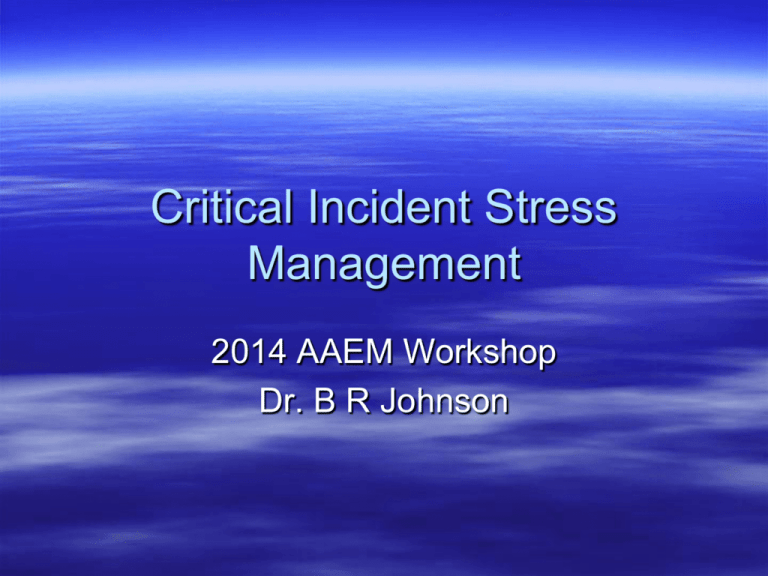
Critical Incident Stress Management 2014 AAEM Workshop Dr. B R Johnson The responder is often a victim as well Crisis An acute response to a Critical Incident wherein: – Psychological homeostasis has been disrupted – Usual coping mechanisms have failed – Some evidence of impairment is present What is Stress? "The nonspecific response of the body to any demand made upon it" (Selye) "Demands on the person which tax or exceed his adjustive resources" (Lazarus) "A particular relationship between the person and the environment that is appraised by the person as taxing or exceeding his/her resources and endangering his/her well-being" Components of Stress necessary for life subjective anything that Threatens us Pushes us positive and negative Scares us Worries us Thrills us Prolonged Stress… Physical Effects muscle tension headaches lack of energy stomach problems immune system high blood pressure strokes sexual problems Prolonged Stress... Psychological effects depression anxiety anger confusion irritability impatience fear negativism memory problems helpless/hopeless Prolonged Stress... Behavioral effects Alcohol and drug use Change in usual behavior Withdrawal Acting out Silence / talkative Under / Overeating Hypervigilance Impulsive HISTORY Trauma has been around forever During WW I it was called “shell shock” In WW II we called it “lack of moral fibre” Twice as many Viet Nam vets have committed suicide as were killed in the war We’re learning how to manage traumatic stress CISM is not psycho therapy WHAT KINDS OF INCIDENTS CAN TRIGGER CIS? A line of duty death The death of a child Incidents involving single / multiple casualties or injuries Significant injury/threat to firefighters Incidents attracting heavy media coverage Major Accidents (Air Crashes, etc.)… Line of Duty Death(s)… Serious Line of Duty Injury(s)… Suicide of a Co-Worker… Disaster / Multi-Casualty Incident(s)… Shooting(s)… REMEMBER CIS IS A NORMAL REACTION TO AN ABNORMAL EXPERIENCE Why Prepare? “The psychological states of emergency response personnel can have a direct effect on the mental and physical health of survivors of a trauma or disaster” (Glass, 1956) Seven Basic Truths Many experiences can be traumatic Some are traumatic to some, but not to all Various factors may make some more vulnerable than others Traumas create reactions now and later Experiencing these reactions means the situation was serious for you Reactions sometimes get worse before they get better Sometimes they reappear later Critical Incidents Are events which have significant power to overwhelm an individual’s normally effective ability to cope Individuals who experience a critical incident are faced with the demand to respond They often respond in ways which require exceptional physical or heroic effort Critical Incidents Critical Incident Stress affects nearly 90% of all emergency personnel Are emotionally charged events The effects of critical incident stress can be intensified, influenced, or mitigated by our personal, family, and developmental issues Symptoms usually subside within a few weeks Crisis Intervention Urgent and acute psychological “first aid” characterized by: – Immediacy – Proximity – Expectancy – Brevity Goals of Crisis Intervention Stabilization of symptoms Mitigation of symptoms Restoration of independent functioning Facilitation to higher level of care if necessary At the heart of any field of study or practice resides a basic vocabulary. Unfortunately, the field of crisis and disaster mental health intervention has been plagued by the lack of a standardized nomenclature. So we will review several key terms and concepts for clarification. Definitions CRITICAL INCIDENTS are unusually challenging events that have the potential to create significant human DISTRESS and can overwhelm one’s usual coping mechanisms. In other words, and abnormal event that evokes a normal response (CIS/PTS) to that abnormal event Definitions The psychological DISTRESS in response to critical incidents such as emergencies, disasters, traumatic events, terrorism, or catastrophes is called a PSYCHOLOGICAL CRISIS (Everly & Mitchell, 1999) Critical Incident Stress (CIS) is also known as Post Traumatic Stress (PTS), which is not the same as Post Traumatic Stress Disorder (PTSD). CIS/PTS is a normal response of normal people to an abnormal event. CIS/PTS reactions may look similar to some symptoms of PTSD. If the CIS/PTS does not get resolved, it may turn into the disorder (PTSD). Only a trained, Mental Health professional can diagnose PTSD. THE NEED About 50% of disaster workers likely to develop significant distress (Myers & Wee, 2005, Dis. Men. Hlth) As many as 45% of those Directly Exposed to mass disasters may develop PTSD or Depression (North, et al., 1999, JAMA) Dose-response relationship with exposure is a key factor in development of PTSD (DSM-IV R) The Need in EMS? Incidence of Posttraumatic Stress with EMS in urban setting (NYC) (9.3%) met the strict DSM-III-R criteria for PTSD Another (10%) had the required number and combination of symptoms for PTSD, but these symptoms had not persisted for the 1 month required by the DSM-III-R criteria. Thus, a total of 19.3% of subjects who completed the survey were shown to be suffering from PTSD symptoms. Development of Posttraumatic Stress Disorder in Urban Emergency Medical Service Workers, Medscape Psychiatry & Mental Health eJournal 2(5), 1997. © 1997 Medscape The Need in EMS? (cont.) The interaction between age and several other factors, however, was significant, including: – Study participants between the ages of 18 and 24 who graduated from a rural high school were nearly 3 times as likely to have PTSD as those from urban or suburban high schools – The prevalence of PTSD increased significantly with the total number of previous medical emergency work jobs Development of Posttraumatic Stress Disorder in Urban Emergency Medical Service Workers, Medscape Psychiatry & Mental Health eJournal 2(5), 1997. © 1997 Medscape Lessons Learned From The Workplace Post disaster crisis intervention (CISM) was associated with reduced risk for: – – – – major depression anxiety disorder global impairment compared with comparable individuals who did not receive this intervention (Boscarino, et al, IJEMH, 2005). Crisis Intervention (CI) An active, short-term, supportive, helping process. Acute intervention designed to mitigate the crisis response (CIS/PTS). NOT psychotherapy or a substitute for psychotherapy. Crisis Intervention (CI) Goals: 1. Stabilization 2. Symptom reduction 3. Return to adaptive functioning, or 4. Facilitation of access to continued care (adapted from Caplan, 1964, Preventive Psychiatry) IMPORTANT! Crisis intervention targets the RESPONSE, not the EVENT, per se. Thus, crisis intervention and disaster mental health interventions must be predicated upon assessment of need. Important CISD Considerations & Ground Rules Strict Confidentiality agreed upon by participants and team Timing is important Location and physical environment appropriate Closed circle format Participation voluntary No notes, recording devices No breaks (Try to limit breaks until after group is finished) Not operational critique, not investigation Not a “blame” session Not therapy, nor substitute for treatment Psychological Crisis An acute RESPONSE to a trauma, disaster, or other critical incident wherein: 1. Psychological homeostasis (balance) is disrupted (increased stress) 2. One’s usual coping mechanisms have failed 3. There is evidence of significant distress, impairment, dysfunction (PTS/CIS) (adapted from Caplan, 1964, Preventive Psychiatry) Comparison San Diego, CA Cerritos, CA Air Crash - 1978 Air Crash - 1986 Total Killed Plane Survivors Homes Destroyed Killed On Ground Emergency Personnel Body Parts Found 125 0 16 15 300 10,000 82 0 16 15 300 10,000 Comparison Support Services Provided San Diego, CA Cerritos, CA Air Crash - 1978 Air Crash - 1986 Sporadic One on One On Scene One on One Demobilizations 12 Debriefings Hot Line Number One on One Follow Up Comparison Personnel Lost in 1 Year San Diego, CA Cerritos, CA Air Crash - 1978 Air Crash - 1986 Police 5 Fire 7 Paramedics 17 Increase in Mental Health Services increase of 31% - 1 1% increase of Example 1… 100 trauma victims Intervention began after 6 months Average cost = $46,000.00 ea. 94% filed civil litigation Friedman, et al, EAP Digest, 1988 Example 2… 100 trauma victims Intervention began within 6 months Average cost = $8,300.00 ea. 13% filed civil litigation Friedman, et al, EAP Digest, 1988 Critical Incident Stress can be MANAGED! Normal signs and symptoms of stress Physical Symptoms: – – – – – – – – – – Nausea Tremors Chills Diarrhea Rapid heart rate Muscle aches Dry mouth Shaking Visual problems Fatigue Emotional Symptoms: – – – – – – – – – Anxiety Denial Fear Survivor guilt Uncertainty of feelings Depression Grief Hopelessness Feeling overwhelmed, lost, or abandoned – Wishing to hide or die – Anger – Feeling numb Normal signs and symptoms of stress Behavioral: – – – – – – – – – – Change in activity Withdrawal Suspiciousness Change in communication patterns Changes in interpersonal interactions Variations in food consumption Excessive humor Excessive silence Unusual behavior Increased smoking or alcohol consumption Cognitive: – – – – – – – – – Confusion Inability to pay attention Difficulty calculating Memory problems Inability to concentrate Repeated flashbacks Nightmares Blaming others Disrupted logical thought process HOW DO WE MANAGE CIS? We do this through a program called Critical Incident Stress Management. The components of CISM are: PRE-INCIDENT EDUCATION ON SCENE INTERVENTIONS DEFUSINGS DEBRIEFINGS FOLLOW UP CISM is a strategic intervention system. It possesses numerous tactical interventions of which CISD is one. CISM increases the rate of normal recovery, in normal people, who are having normal reactions to abnormal events CISM Critical Incident Stress Management was first recognized and techniques to respond were developed in the 1980’s The first team was in Virginia, today there are hundreds of teams worldwide CISM Was designed to assist in the prevention, management, and recovery from a significant stress Include pre-incident education, defusing, debriefings, support services, follow-up services, individual consults, peer counseling, and disaster management CISM interventions are provided by especially trained individuals A seven phase process developed to: Minimize the emotional and physical impact of an event Prevent burn-out Educate participants regarding normal stress reactions Mitigate stress responses Help to keep careers, relationships, and physical/mental health intact with little residual damage Can be delivered in a 6 hour course Defusing Defusing: – An abbreviated version of a debriefing in a small group process – Helpful when a full debriefing cannot be organized – Is held very soon after the event—ideal time within first 3 hours post event – Three main segments: Introduction Exploration information – Four main goals: Rapid reduction in the intensity to reactions A normalizing experience Re-establishment of the social network of the group To assess whether a full debriefing will be necessary DEFUSING Ideal time 1-2 hours after incident 20-45 minutes in length Done in a group, led by a team of Peer debriefer(s) Not an operational critique but venting of emotions The seven phases of a formal debriefing: 1. 2. 3. 4. 5. 6. 7. Introduction Fact phase Thought phase Reaction phase Symptom phase Teaching phase Re-entry phase THE DEBRIEFING PROCESS 1. 2. 3. 4. 5. 6. 7. INTRODUCTION AND GROUND RULES DESCRIPTION OF THE FACTS RESPONDERS THOUGHTS RESPONDERS REACTIONS EXPLANATION OF CIS SYMPTOMS STRATEGIES FOR COPING WITH CIS CONCLUSION DEBRIEFINGS A more in depth version of a Defusing They are held 24-72 hours after an incident Done in a group led by a team of at least one mental health professional, trained in the fire service, and one firefighter trained in CISM. Not an operational critique but venting of emotions A formal debriefing: Ideal debriefing time is between 24 and 72 hours post event Generally lasts for 2-3 hours Is a seven stage process What makes defusings and debriefings effective? Early intervention Opportunity for catharsis Opportunity to verbalize about the trauma with those who experienced it Behavioral structure Psychological structure Group support Peer support Promotes follow-up Demobilization Demobilization: – A very brief intervention that takes place immediately following the event – Primary stress prevention and intervention technique – Two main segments: Brief period where personnel are given information to assist them with management of stress reactions A rest and nutrition/rehydration period prior to return to duties – Goals of demobilization: To provide a transition from the traumatic event or critical incident to the routine To reduce the intensity of immediate stress-related reactions Assessment of group for additional needs To educate the group about potential stress reactions To provide information about additional support To establish positive expectations about outcome Common Problems Failure to understand ingredients of CISM Failure to understand group processes Inappropriate timing of interventions Group size Group is too heterogeneous Incomplete instructions/expectations Participants rush from FACT to REACTION Professionals trained in CISM can provide: Defusing Demobilization Debriefing Recommendations for follow-up Critical Incident Stress No one is immune from responding to the stress of a critical incident Critical incident stress may occur hours, days, or even months after a critical event You may experience symptoms of stress and not even know it Suffering the stress effects following a critical incident stress is NORMAL In the days immediately after a critical event Maintain your schedule, alternate physical activity with relaxation Remember that you are having normal reactions to an abnormal event Reach out and spend time with others---they care It is ok to talk about your feelings After a critical event Do things that feel good to you or provide you with comfort Avoid drugs and alcohol to numb your emotions Keep a journal Don’t make life-altering changes at this time Do make daily decisions and assume control over your life Get plenty of rest, eat nutritiously, and take care of yourself Know your community’s resources! Find out who provides CISM services and make contact, if you or some one that you care about has experienced a critical incident. CONCLUSION You provide a valuable service – the job isn’t easy The likelihood of you being exposed to a critical incident is increasing Just as you take care of your equipment, you need to take care of yourselves
